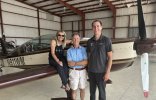So a student (hypothetically) inadvertently puts me into an extreme unusual attitude. What to do? Book learning ain’t enough. I decided that proper instruction would be wise. With some apprehension I signed up for the 5 hour basic acrobatic course at Patty Wagstaff’s Aviation Safety School at the St Augustine FL airport.
I just finished my first day, and I’m still collecting my thoughts about it.
I did 2 sessions today with an excellent instructor Ryan. The first 4 hours you do in a Super Decathlon and the last hour in an Extra 200. After a briefing we flew. I was impressed immediately as to how smooth and responsive the Decathlon is.
For most situations the way out of an unusual attitude is Look, Unload, Roll and Recover. We did a lot to get this ingrained. The morning flight we did power off straight ahead and turning stalls, unusual attitude recoveries, aileron rolls. Oh, the airspeed indicator and turn coordinator are covered the whole flight.
After lunch we did spins, wing overs and half Cuban eights.
After the 2nd half Cuban 8 I admit I needed a barf bag. I never felt bad or particularly queasy, but I just knew I needed one. One issue is the high temperature we’re all suffering with right now.
I never felt uncomfortable or scared on any of the maneuvers (as I thought I might). A good instructor helps in that regard. Inverted wasn’t a big deal, but I did not like the attitude and rotational speed of the spin. I told Ryan I needed to do more of those tomorrow.
Right now I need a good dinner (MANY choices for that in St Augustine) and a good night’s sleep. Then at it again at 8am.
Did I make a good decision on spending some time and money. I think so. There’s no way this doesn’t make you a better and safer pilot. That’s a good thing.
I just finished my first day, and I’m still collecting my thoughts about it.
I did 2 sessions today with an excellent instructor Ryan. The first 4 hours you do in a Super Decathlon and the last hour in an Extra 200. After a briefing we flew. I was impressed immediately as to how smooth and responsive the Decathlon is.
For most situations the way out of an unusual attitude is Look, Unload, Roll and Recover. We did a lot to get this ingrained. The morning flight we did power off straight ahead and turning stalls, unusual attitude recoveries, aileron rolls. Oh, the airspeed indicator and turn coordinator are covered the whole flight.
After lunch we did spins, wing overs and half Cuban eights.
After the 2nd half Cuban 8 I admit I needed a barf bag. I never felt bad or particularly queasy, but I just knew I needed one. One issue is the high temperature we’re all suffering with right now.
I never felt uncomfortable or scared on any of the maneuvers (as I thought I might). A good instructor helps in that regard. Inverted wasn’t a big deal, but I did not like the attitude and rotational speed of the spin. I told Ryan I needed to do more of those tomorrow.
Right now I need a good dinner (MANY choices for that in St Augustine) and a good night’s sleep. Then at it again at 8am.
Did I make a good decision on spending some time and money. I think so. There’s no way this doesn’t make you a better and safer pilot. That’s a good thing.






